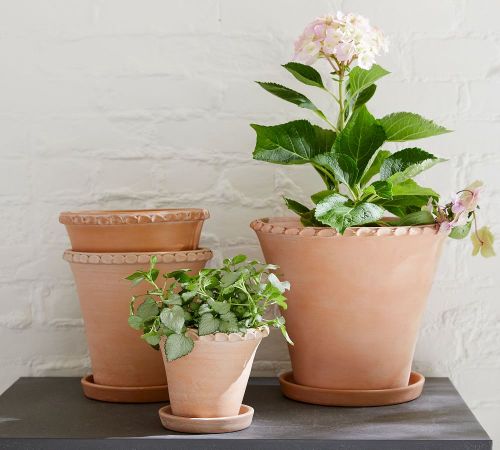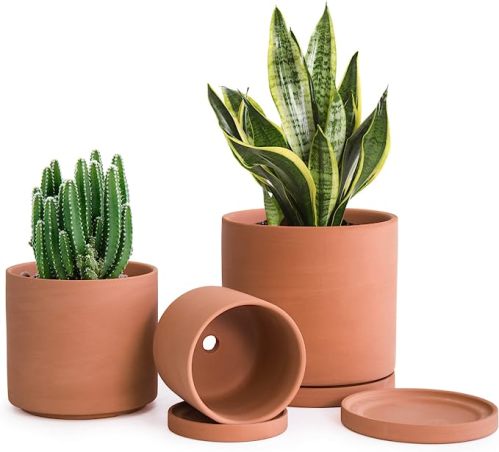Our editors independently select these products. Making a purchase through our links may earn Well+Good a commission
When I picture my grandparents’ house, I can vividly see the beautiful terracotta pots that lined their front and back doorsteps, as well as those on the back deck, lower patio, and pool deck. They filled them with rosemary, pansies, geraniums, roses, and more. The reason? The drainage and durability of terracotta is hard to beat when properly cared for to prevent cracks.
Experts in This Article
Melvin Cubian is a gardening expert at PlantIn, a plant-identifying and gardening advice website.
As someone without much of a green thumb, I never paid much mind to my grandparents’ use of terracotta beyond it becoming a characteristic of my core memories. Now that I live in a home with a front porch worthy of a giant pot of flowers, though, I’m more invested. And even now, Gram swears that terracotta is the way to go. As much as I trust her, given she has over 65 years of gardening experience under her belt, I figured it wouldn’t hurt to chat with a gardening expert about the benefits of planting in the pretty-yet-simple pots, and how to keep terracotta from cracking (since that’s one of the biggest complaints surrounding the pots).
The Benefits of Planting in Terracotta Pots
According to PlantIn gardening expert Melvin Cubian, terracotta pots are known for their absorption. “Because terracotta pots are porous, theoretically, they can reduce the risk of overwatering and fungal diseases by absorbing extra water in the soil,” he explains. That said, he admits that in more recent years, it’s been proven scientifically that the benefit is not that significant compared to plastic pots, so long as they have drainage holes.
Beyond potential absorption perks, Cubian says that terracotta is notably heavier than a plastic pot, which makes it more steadfast for outdoor use where winds and heavy rain could potentially topple over a lightweight pot.
Additionally, while rather simple in design, they have a certain charm. “One of the appeals of terracotta pots is actually how they take on character as they age, which many people gravitate towards for a vintage feel for their homes and gardens,” says Rebecca Sears, chief gardening “guru” at Ferry-Morse. “Plus, using terracotta pots instead of planting your seeds directly in the ground also allows you more opportunity to get creative with landscaping and place your plants in different areas of your garden.”

Pennington, 12 in. Terra Cotta Clay Pot — $15.00
How To Care for Terracotta Pots
Why are terracotta pots prone to cracking?
Terracotta pots might be more durable for outdoor use but thanks to their porous nature, they can crack over time. The reason?
“When the pot’s micropores are filled with water and exposed to cold temperatures, the water can expand and cause pressure in the cavities,” says Cubian. “The repetitive freezing and thawing process weakens its overall structure, causing it to crack over time.”

Pottery Barn, Provence Scalloped Edge Planter-Terra Cotta — $25.00
How do I prevent terracotta pots from cracking?
If you love using terracotta for your planters, the trick to preventing them from cracking is to keep them in a climate-controlled area. Of course, if you use them outdoors, this can be tricky, as you likely won’t want to lug in a heavy pot every time it’s anything less than sunny. With that in mind, Cubian says to simply bring your terracotta in when freezing temperatures are on the radar. After all, if they get wet, that’s not a problem. It’s when they freeze and then thaw out that the pores of the terracotta become weakened.
While large cracks are rather irreparable, Sears says that if you find a few small cracks in your terracotta pot, you can even just seal them using epoxy (like Milliput’s 2-Part Self Hardening Putty) to avoid further breakage.”

Milliput 2-Part Self Hardening Putty, Terracotta — $11.00

D'vine Dev, Terracotta Pots — $29.00
How do I keep terracotta pots clean and free of pests?
It’s important to think about your terracotta pots beyond their potential to break. “It’s important to clean the pots at the end of every growing season to avoid pests and diseases that will attack plants,” Sears says. “Some gardeners even like to go the extra mile by soaking it in one part bleach and nine parts water, to ensure it is sterilized.”
Sign up for the Well+Good SHOP Newsletter
Get exclusive deals on wellness, beauty, fitness, and food products that have been hand-picked by our editors.
Got it, you've been added to our email list.









